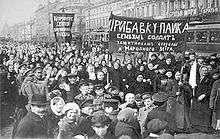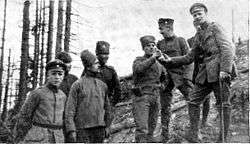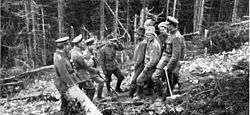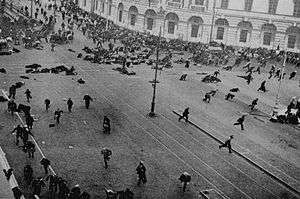February Revolution
| February Revolution | |||||||
|---|---|---|---|---|---|---|---|
| Part of the Russian Revolution of 1917 | |||||||
| |||||||
| Belligerents | |||||||
|
Gendarmes MVD Department of Police Petrograd garrison |
Petrograd garrison (later days) | ||||||
| Commanders and leaders | |||||||
|
|
| ||||||
| Casualties and losses | |||||||
| 1,443 killed (Petrograd alone)[1] | |||||||
The February Revolution (Russian: Февра́льская револю́ция; IPA: [fʲɪvˈralʲskəjə rʲɪvɐˈlʲutsɨjə], known in Soviet historiography as the February Bourgeois Democratic Revolution[2]) was the first of two revolutions in Russia in 1917. It was centered on Petrograd (now known as St. Petersburg), then the Russian capital, on Women's Day in March (late February in the Julian calendar).[3] The revolution was confined to the capital and its vicinity, and lasted less than a week. It involved mass demonstrations and armed clashes with police and gendarmes, the last loyal forces of the Russian monarchy. In the last days, mutinous Russian Army forces sided with the revolutionaries. The immediate result of the revolution was the abdication of Tsar Nicholas II, the end of the Romanov dynasty, and the end of the Russian Empire. The Tsar was replaced by a Russian Provisional Government under Prince Georgy Lvov. The Provisional Government was an alliance between liberals and socialists who wanted political reform. They set up a democratically-elected executive and constituent assembly. At the same time, socialists also formed the Petrograd Soviet, which ruled alongside the Provisional Government, an arrangement termed Dual Power.
The revolution appeared to break out spontaneously, without any real leadership or formal planning. Russia had been suffering from a number of economic and social problems, which were compounded by the impact of World War I. Bread rioters and industrial strikers were joined on the streets by disaffected soldiers from the city's garrison. As more and more troops deserted, and with loyal troops away at the Front, the city fell into chaos, leading to the overthrow of the Tsar.
The February Revolution was followed in the same year by the October Revolution, bringing Bolshevik rule and a change in Russia's social structure, and paving the way for the Soviet Union.
Causes
A number of factors contributed to the downfall of the Imperial government in the spring of 1917, both short and longer term. Different historians apply different weights to different factors: liberal historians emphasise the turmoil created by the war, whereas Marxists emphasise the inevitability of change.[4]
Rabinowitch summarizes the main long-term and short-term causes:
- The February 1917 revolution...grew out of prewar political and economic instability, technological backwardness, and fundamental social divisions, coupled with gross mismanagement of the war effort, continuing military defeats, domestic economic dislocation, and outrageous scandals surrounding the monarchy.[5]
Long-term causes
Despite its occurrence at the height of World War I, the roots of the February Revolution date much further back. Chief among these was Imperial Russia's failure, throughout the 19th and early 20th century, to modernize its archaic social, economic and political structures while maintaining the stability of ubiquitous devotion to an autocratic monarch. As historian Richard Pipes writes, "the incompatibility of capitalism and autocracy struck all who gave thought to the matter".[6]
The first major event of the Russian Revolution was the February Revolution, which was a chaotic affair, caused by the culmination of over a century of civil and military unrest. The causes of this unrest of the common people towards the Tsar and aristocratic landowners are many and can be summarized as the ongoing cruel treatment of peasants by patricians, poor working conditions of city workers in the fledgling industrial economy and the spreading of democratic ideas from the West by political activists, leading to a growing political and social awareness of the lower classes. Dissatisfaction of proletarians was compounded by food shortages and military failures. In 1905, Russia experienced humiliating losses in its war with Japan, then Bloody Sunday and the Revolution of 1905, Tsarist troops fired upon a peaceful, unarmed crowd—further dividing Nicholas II from his people. Widespread strikes, riots and the famous mutiny on the Battleship Potemkin ensued.
These conditions caused much agitation among the small working and professional classes. This tension erupted into general revolt with the 1905 Revolution, and again under the strain of war in 1917, this time with lasting consequences.
Short-term causes

The revolution was provoked by Russian military failures during the First World War,[7] as well as public dissatisfaction with the way the country was run on the Home Front. The economic challenges faced due to fighting a total war also contributed.
In August 1914, all classes supported[8] and virtually all political deputies voted in favour of the war.[9] The exceptions included the Bolshevik Party and specifically Vladimir Lenin who argued it was not a war worth fighting, and who were called "defeatists". The declaration of war was followed by a revival of nationalism across Russian society, which temporarily reduced internal strife.[7] The army achieved some early victories (such as in Galicia in 1915 and with the Brusilov Offensive in 1916) but also suffered major defeats, notably Tannenberg in August 1914, the Winter Battle in Masuria in February 1915 and the loss of Russian Poland during May to August 1915. Nearly six million casualties—dead, wounded and missing—had been accrued by January 1917. Mutinies sprang up more often (most due to simple war-weariness), morale was at its lowest, and the (newly called up) officers and commanders were at times very incompetent. Like all major armies, Russia's armed forces had inadequate supply.[10] The pre-revolution desertion rate ran at around 34,000 a month.[11] Meanwhile, the wartime alliance of industry, Duma and Stavka (Military High Command) started to work outside the Tsar's control.[12]
In an attempt to boost morale and repair his reputation as a leader, Nicholas announced in the summer of 1915 that he would take personal command of the army, in defiance of almost universal advice to the contrary.[4] The result was disastrous on three grounds. Firstly, it associated the monarchy with the unpopular war; secondly, Nicholas proved to be a poor leader of men on the front, often irritating his own commanders with his interference; and thirdly, being at the front made him unavailable to govern. This left the reins of power to his wife, the German Tsarina Alexandra, who was unpopular and accused of being a spy and under the thumb of her confidant Grigori Rasputin, himself so unpopular that he was assassinated by members of the nobility in December 1916.[7] The Tsarina proved an ineffective ruler in a time of war, announcing a rapid succession of different Prime Ministers and angering the Duma.[7] The lack of strong leadership is illustrated by a telegram from Octobrist politician Mikhail Rodzianko to the Tsar on 11 March [O.S. 26 February] 1917, in which Rodzianko begged for a minister with the "confidence of the country" be instated immediately. Delay, he wrote, would be "tantamount to death".[13]
On the home front, a famine loomed and commodities became scarce due to the overstretched railroad network. Meanwhile, refugees from German-occupied Russia came in their millions.[14] The Russian economy, which had just seen one of the highest growth rates in Europe, was blocked from the continent's markets by the war. Though industry did not collapse, it was considerably strained and when inflation soared, wages could not keep up.[15] The Duma (lower house of parliament), composed of liberal deputies, warned Tsar Nicholas II of the impending danger and counselled him to form a new constitutional government, like the one he had dissolved after some short-term attempts in the aftermath of the 1905 Revolution. The Tsar ignored the advice. Historian Edward Acton argues that "by stubbornly refusing to reach any modus vivendi with the Progressive Bloc of the Duma... Nicholas undermined the loyalty of even those closest to the throne [and] opened an unbridgeable breach between himself and public opinion."[4] In short, the Tsar no longer had the support of the military, the nobility or the Duma (collectively the élites), or the Russian people. The result was revolution.[16]
Events
Protests

The first major protest of the February Revolution occurred on 7 March 1917 (O.S. 22 February) as workers of Putilov (later called Kirov Plant), Petrograd’s largest industrial plant, announced a strike to demonstrate against the government.[17] By 1917, the majority of Russians had lost faith in the Tsarist regime.[18] Government corruption was unrestrained, and Tsar Nicholas II had frequently disregarded the Dumas.[19] Thousands of workers flooded the streets of Petrograd (modern St. Petersburg) to show their dissatisfaction.[20]
On 8 March (O.S. February 23), Putilov protesters were joined in uprising by those celebrating International Woman's Day and protesting against the government's implemented food rationing.[21] As the Russian government began rationing flour and bread, rumors of food shortages circulated and bread riots erupted across the city of Petrograd.[22] Women, in particular, were passionate in showing their dissatisfaction with the implemented rationing system, and the female workers marched to nearby factories to recruit over 50,000 workers for strike.[23] Both men and women flooded the streets of Petrograd with red flags and banners which read “Down with the Autocracy!”.[24] By the following day [O.S. February 24], nearly 200,000 protesters filled the streets, demanding the replacement of the Tsar with a more progressive political leader.[25] The protesting mob called for the war to end and for the Russian monarchy to be overthrown.[26] By 10 March [O.S. 25 February], nearly all industrial enterprises in Petrograd were shut down by the uprising.[27]
The Tsar took action to address the riots on 10 March (O.S. 25 February) by wiring garrison commander General Khabalov to disperse the crowds with rifle fire.[28] At least 180,000 troops were available in the capital, but most were either partially trained recruits or older working-class reservists from the Petrograd area recalled for duty. The reserve battalions of the Imperial Guard, which made up the bulk of the Petrograd garrison, had a serious shortage of officers and the morale and discipline of these units was low. Historian Ian Beckett suggests around 12,000 of the soldiers could be regarded as reliable, but even these proved reluctant to fire on the demonstrators, both out of fellow feeling and because the crowds included so many women. Rumors spread that police had been armed with machine guns and placed in the upper stories of buildings throughout the city. While apparently unfounded,[29] these reports resulted in attacks on individual policemen throughout the city. Meanwhile, some soldiers mutinied.[30] Then, on 11 March [O.S. 26 February], the Tsar ordered the army to suppress the rioting by force, but troops mutinied and joined the protesters.[31] On the morning of 12 March (O.S. 27 February), mutinous soldiers of the Fourth Company of the Pavlovski Replacement Regiment refused to fall in on parade when commanded, shot two officers, and joined the protesters on the streets.[32] Other regiments quickly joined in the mutiny, resulting in the hunting down of police and the gathering of 40,000 rifles which were dispersed among the workers.[33]
By nightfall of 12 March (O.S. 27 February), General Khabalov and his forces faced a capital controlled by revolutionaries.[34] The protesters of Petrograd burned down government buildings, seized the arsenal, and released prisoners into the city.[35] Army officers retreated into hiding and many took refuge in the Admiralty building of Petrograd. In all, over 1,300 people were killed in the protests of March (O.S. February) 1917.[36]
Tsar's return and abdication


The Tsar had returned to his frontline base at Stavka on 7 March [O.S. 22 February]. After violence erupted, however, Mikhail Rodzianko, Chairman of the Duma, sent the Tsar a report of the chaos in a telegram (exact wordings and translations differ, but each retains a similar sense[13]):
The situation is serious. The capital is in a state of anarchy. The Government is paralyzed. Transport service and the supply of food and fuel have become completely disrupted. General discontent is growing... There must be no delay. Any procrastination is tantamount to death.
Nicholas' response on 12 March [O.S. 27 February], perhaps based on the Empress' earlier letter to him that the concern about Petrograd was an over-reaction, was one of irritation that "again, this fat Rodzianko has written me lots of nonsense, to which I shall not even deign to reply."[37] Meanwhile, events unfolded in Petrograd. The bulk of the garrison mutinied, starting with the Volynsky Life Guards Regiment. Even the Cossack units that the government had come to use for crowd control showed signs that they supported the people. Although few actively joined the rioting, many officers were either shot or went into hiding; the ability of the garrison to hold back the protests was all but nullified, symbols of the Tsarist regime were rapidly torn down around the city and governmental authority in the capital collapsed — not helped by the fact that Nicholas had prorogued the Duma that morning, leaving it with no legal authority to act. The response of the Duma, urged on by the Progressive Bloc, was to establish a Provisional Committee to restore law and order; meanwhile, the socialist parties re-established the Petrograd Soviet, first created during the 1905 revolution, to represent workers and soldiers. The remaining loyal units switched allegiance the next day.[38]
The Army Chiefs and the ministers who had come to advise the Tsar suggested that he abdicate the throne. He did so on 15 March [O.S. 2 March], on behalf of himself and his son, Tsarevich Alexei.[31] Nicholas nominated his brother, the Grand Duke Michael Alexandrovich, to succeed him. But the Grand Duke realised that he would have little support as ruler, so he declined the crown on 16 March [O.S. 3 March],[31] stating that he would take it only if that was the consensus of democratic action by the Russian Constituent Assembly, which shall define the form of government for Russia.[39] Six days later, the former Tsar, addressed with contempt by the sentries as "Nicholas Romanov", was reunited with his family at the Alexander Palace at Tsarskoye Selo.[40] He and his family and loyal retainers were placed under protective custody by the Provisional Government.[41]
Provisional Government and Petrograd Soviet share power

_Chkheidze_(1864-1926)%2C_Georgian_Menshevik_politician_(small).jpg)
The immediate effect of the February Revolution was widespread excitement in Petrograd.[42] On 16 March [O.S. 3 March], a provisional government was announced. The center-left was well represented, and the government was initially chaired by a liberal aristocrat, Prince Georgy Yevgenyevich Lvov, a man with no connections to any official party.[43] The socialists had formed their rival body, the Petrograd Soviet (or workers' council) four days earlier. The Petrograd Soviet and the Provisional Government shared dual power over Russia. The Soviet had the stronger case for power because it controlled the workers and the soldiers, but it did not want to be involved in administration and bureaucracy.
The Provisional Government chafed at not having absolute control over all aspects of government, and tried many times to convince the Soviet to join it. Instead, it grudgingly cooperated with the Soviet from February to April. This arrangement became known as the "Dual Authority" or "Dual Power". However, the de facto supremacy of the Soviet was asserted as early as 14 March [O.S. 1 March] (before the creation of the Provisional Government), when the Soviet issued Order No. 1:
The orders of the Military Commission of the State Duma [part of the organisation which became the Provisional Government] shall be executed only in such cases as do not conflict with the orders and resolution of the Soviet of Workers' and Soldiers' Deputies.
Order No. 1 thus ensured that the Dual Authority developed on the Soviet's conditions. As the Provisional Government was not a publicly elected body (having been self-proclaimed by committee members of the old Duma), it lacked the political legitimacy to question this arrangement and instead arranged for elections to be held later.[44]
Aftermath
Vladimir Lenin, exiled in neutral Switzerland, arrived in Petrograd from Zürich on 3 April 1917 O.S. He immediately began to undermine the provisional government, issuing his April Theses the next month. These theses were in favour of "revolutionary defeatism", as opposed to the "imperialist war" (whose "link to Capital" must be demonstrated to the masses) and the "social-chauvinists" (such as Georgi Plekhanov, the grandfather of Russian socialism), who supported the war. Lenin also tried to take control of the Bolshevik movement and stirred up the proletariat against the government with simple but meaningful slogans such as "Peace, bread and land", "End the war without annexations or indemnities", "All power to the Soviet" and "All land to those who work it".

Initially, Lenin and his ideas did not have widespread support, even among Bolsheviks.[45] In what became known as the July Days, approximately half a million people came out onto the streets of Petrograd in protest, including soldiers and sailors; Lenin was unable to direct them into an organised coup. The demonstrators, lacking leadership, disbanded and the government survived. However, the Provisional Government considered it a Bolshevik coup attempt and issued arrest warrants for prominent Bolsheviks. Lenin fled to Finland and other members of the Bolshevik party were arrested.[46] Lvov was replaced by the Socialist Revolutionary minister Alexander Kerensky as head of the government.
Kerensky declared freedom of speech, ended capital punishment, released thousands of political prisoners and did his best to maintain Russian involvement in World War I, but he faced many challenges, most of them related to the war: there were still very heavy military losses on the front; dissatisfied soldiers deserted in larger numbers than before; other political groups did their utmost to undermine him; there was a strong movement in favour of withdrawing Russia from the war, which was seen to be draining the country, and many who had initially supported it now wanted out; there was a great shortage of food and supplies, which was very difficult to remedy in wartime conditions. All of these were highlighted by the soldiers, urban workers and peasants, who claimed that little had been gained by the February Revolution. Kerensky was expected to deliver on his promises of jobs, land, and food almost instantaneously, and he had failed to do so.
Another issue for Kerensky, the Kornilov Affair, arose when Commander-in-Chief of the Army, General Lavr Kornilov, directed an army under Aleksandr Krymov to march toward Petrograd with Kerensky's agreement.[47] Although the details remain sketchy, Kerensky appeared to become frightened by the possibility of a coup and the order was countermanded. (Historian Richard Pipes is adamant that the episode was engineered by Kerensky[48]). On 27 August, feeling betrayed by the Kerensky government who had previously agreed with his views on how to restore order to Russia, Kornilov pushed on towards Petrograd. With few troops to spare on the front, Kerensky was forced to turn to the Petrograd Soviet for help. Bolsheviks, Mensheviks and Socialist Revolutionaries confronted the army and convinced them to stand down.[49] Right-wingers felt betrayed, and the left wing was resurgent. Pressure from the Allies to continue the war against Germany put the government under increasing strain. The conflict between the "diarchy" became obvious, and, ultimately, the regime and the dual power formed between the Petrograd Soviet and the Provisional Government instigated by the February Revolution was replaced in the October Revolution.
See also
- Russian Revolution of 1917
- 1905 Russian Revolution
- World War I
- Vladimir Lenin
- Women in the Russian Revolution
- Nicholas and Alexandra a biographical film of the Tsar and his family.
Notes
- ↑ Orlando Figes (2008). A People's Tragedy. First. p. 321. ISBN 9780712673273.
- ↑ Aluf, I. A. (1979). February Bourgeois Democratic Revolution of 1917. The Great Soviet Encyclopedia (3rd ed.). The Gale Group, Inc.
- ↑ History of the Women's Day. United Nations website.
- 1 2 3 Acton 1990, pp. 107–108.
- ↑ Alexander Rabinowitch (2008). The Bolsheviks in Power: The First Year of Soviet Rule in Petrograd. Indiana UP. p. 1. ISBN 0253220424.
- ↑ Pipes 2008, p. 18.
- 1 2 3 4 Fitzpatrick 2008, p. 38.
- ↑ Service 2005, p. 26.
- ↑ Of 422, only 21 voted against. Beckett 2007, p. 516.
- ↑ Beckett 2007, pp. 521–522.
- ↑ Beckett 2007, p. 525.
- ↑ Beckett 2007, p. 518.
- 1 2 3 4 Browder & Kerensky 1961, p. 40.
- ↑ Beckett 2007, p. 513.
- ↑ Beckett 2007, p. 516.
- ↑ Fitzpatrick 2008, pp. 39–40.
- ↑ Curtis 1957, p. 30.
- ↑ February Revolution Begins in Russia.
- ↑ February Revolution Begins in Russia.
- ↑ Curtis 1957, p. 1.
- ↑ Williams 1987, p. 9.
- ↑ Williams 1987, p. 9.
- ↑ When women set Russia ablaze 2007.
- ↑ Curtis 1957, p. 1.
- ↑ Curtis 1957, p. 1.
- ↑ Williams 1987, p. 9.
- ↑ Curtis 1957, p. 30.
- ↑ Curtis 1957, p. 30.
- ↑ Salisbury, Harrison E. Black Night White Snow. p. 372. ISBN 0-306-80154-X.
- ↑ Curtis 1957, p. 30.
- 1 2 3 Beckett 2007, p. 523.
- ↑ Wildman 1970, p. 8.
- ↑ Curtis 1957, p. 30.
- ↑ Wildman 1970, p. 8.
- ↑ Wildman 1970, p. 8.
- ↑ Curtis 1957, p. 30.
- ↑ Wade 2005, p. 37.
- ↑ Wade 2005, pp. 40–43.
- ↑ Browder & Kerensky 1961, p. 116.
- ↑ Tames 1972, p. .
- ↑ Service 1986, p. .
- ↑ Malone 2004, p. 92.
- ↑ Service 2005, p. 34.
- ↑ Service 2005, p. 57.
- ↑ Beckett 2007, p. 527.
- ↑ Fitzpatrick 2008, p. 58.
- ↑ Beckett 2007, p. 526.
- ↑ Pipes 1997, p. 51, "There is no evidence of a Kornilov plot, but there is plenty of evidence of Kerensky's duplicity.".
- ↑ Service 2005, p. 54.
References
| Wikimedia Commons has media related to February Revolution (Russia). |
- Acton, Edward (1990). Rethinking the Russian Revolution. Oxford University Press US. ISBN 978-0-7131-6530-2.
- Beckett, Ian F.W. (2007). The Great war (2 ed.). Longman. ISBN 978-1-4058-1252-8.
- Browder, Robert Paul; Kerensky, Aleksandr Fyodorovich (1961). The Russian Provisional Government, 1917: documents. Stanford University Press. ISBN 978-0-8047-0023-8.
- Fitzpatrick, Sheila (2008). The Russian Revolution. Oxford University Press US. ISBN 978-0-19-923767-8.
- Malone, Richard (2004). Analysing the Russian Revolution. Australia: Cambridge University Press. p. 67. ISBN 0-521-54141-7.
- Pipes, Richard (1997). Three "whys" of the Russian Revolution. Vintage Books. ISBN 978-0-679-77646-8.
- Pipes, Richard (2008). A Concise History of the Russian Revolution. Paw Prints. ISBN 978-1-4395-0680-6.
- Rabinowitch, Alexander (2008). The Bolsheviks in Power: The First Year of Soviet Rule in Petrograd. Indiana UP. p. 1. ISBN 0253220424.
- Service, Robert (1986). The Russian Revolution. Macmillan Education. ISBN 978-0-333-38819-8.
- Service, Robert (2005). A history of modern Russia from Nicholas II to Vladimir Putin. Harvard University Press. ISBN 978-0-674-01801-3.
- Tames, Richard (1972). Last of the Tsars. London: Pan Books Ltd. ISBN 978-0-330-02902-5.
- Wade, Rex A. (2005). The Russian Revolution, 1917. Cambridge University Press. ISBN 978-0-521-84155-9.
Online sources
- "When women set Russia ablaze". fifthinternational.org. League for the Fifth International. 11 July 2007. Retrieved 1 September 2012.
External links
- http://web.archive.org/web/20100107023609/http://www.thecorner.org:80/hist/russia/revo1917.htm
- Leon Trotsky's account
- Лютнева революція. Жіночий бунт, який знищив Російську імперію (February Revolution. Female mutiny that destroyed the Russian Empire). Ukrayinska Pravda
